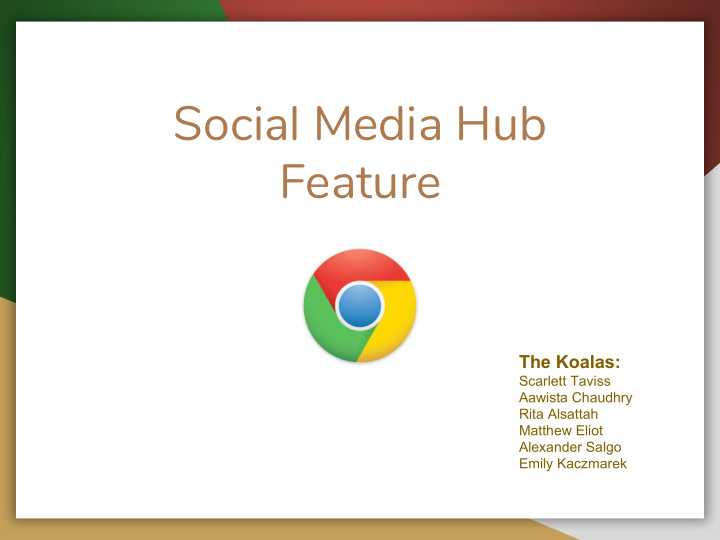



Social Media Hub Feature The Koalas: Scarlett Taviss Aawista Chaudhry Rita Alsattah Matthew Eliot Alexander Salgo Emily Kaczmarek
Feature: Social Media Notification Icons
SAAM - Scenarios 1. Display notifications for multiple different social media accounts 2. Access websites every 10 seconds to update notifications 3. User personalizes which social media accounts to display 4. Click icon to open relevant social media website in new tab 5. Play sound when new notification is received
SAAM - Implementation 1
SAAM - Implementation 2
SAAM - Stakeholders & NFRs Quality Attributes: Stakeholders: - Maintainability - Dev Team - Evolvability - Chrome - Testability - Users - Performance - Security
SAAM - Testing the NFRs Maintainability: “99% of updates can be performed without any interruption to user experience.” Evolvability: “New information can be interpreted and displayed from a supported website by a junior developer.” Testability: “ Tests run when opening supported social media sites do not result in an increase in page load time of more than 50 ms.” Performance: “ 95% of newly received notifications result in an icon update within 10 seconds.” Security: “ No information about the partially rendered social media sites is unsecured during notification check portion.”
SAAM - Advantages/Disadvantages QA Model 1 Model 2 Update = difficult, code Update = easy, most code within Maintainability C A distributed within subsystems Plugin, less coupling with Chrome Existing rendering system → Partial rendering subsystem → Evolvability B+ C easier to interpret/render may require significant changes Reuse renderer processes for Page rendered and partially Testability A page loading, sending B rendered when testing occurs notification info, etc. Additional renderer process: ↑ A Performance B+ No major issues expected overhead (slightly) Pages rendered in Renderer = sandboxed, only non-sandboxed environment → F Security A notification info sent outside major security risk
Impacted Subsystems Maintains object-oriented architecture style. User Interface - Used to display the social media notifications. Browser: - Performs auto checks on each social media site, calling to the renderer every 10 seconds. - Compares and updates notifications Renderer - Retrieves the notifications from the social media site.
Sequence Diagram
Risks/Limitations of Approach - Difficult to update - Choking the Network - Increase in resources used - Reduced concurrency
Concurrency - Multi-process architecture - Reduces system concurrency by using a renderer - Larger impact on smaller machines - Multiple threads - Allows for testing
Testing Impact of Interactions - User receives notification: - Notification appears on screen - Only one icon is updated - User clicks notification: - New tab is opened - Notification number matches webpage - User updates social media preferences
Team Issues Core team to implement feature: Renderer Secondary team: DOM Teams to Consult: UI, Browser Concrete Architecture of Renderer Subsystem
Limitations & Lessons Learned - Differentiating between quality attributes (Maintainability vs Evolvability) - Implementing a new feature in Chrome requires a lot of consideration and testing - Thinking like a developer: SAAM, Testing, Implementation
Conclusion - Motivation: Enhanced user experience - SAAM Analysis of 2 possible implementations helped us determine final approach - Impacted subsystems: UI, Browser, Renderer - Immense amount of considerations taken in developing a new feature in Chrome
Questions?
Recommend
More recommend